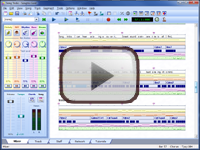(9.8) Musical Dynamics
By now, we have explored a wide range of techniques that you can use to add melodic, harmonic, and rhythmic originality to your compositions.
One final aspect of interest remains, that of musical dynamics, which are the variations in the loudness of the notes in a piece of music. There are two levels at which dynamics occur.
At the micro level, each note in a piece of music can be played with a different strength. With a musician, this is unavoidable, but as with variations in timing (discussed earlier) it is also desirable, and contributes greatly to the natural expression of the playing.
With computer music, note strength is called velocity. It is possible to play notes at a constant velocity, but it generally sounds flat and expressionless, so most music software has a humanize function to add a degree of random variation for a more pleasing sound.

ChordWizard products such as Songtrix offer a Velocitize function, which you can use to add a controllable level of randomness to the velocities of notes.
Strength of individual notes can be indicated in staff notation with articulations of force. Shown below are the three most commonly used of these.

Dynamics can also be indicated at the macro level for a piece of music as a whole. This might be only once at the start, or several times throughout if the loudness changes during different sections.
Changing dynamics is very common for dramatic effect in classical music, but also regularly appears in contemporary music, especially for the very popular 'repeat and fade' ending.
Dynamics markings in staff notation are based on three Italian terms - piano (soft), forte (loud) and mezzo (medium). The following combinations are possible, going from softest to loudest:
ppp - extremely soft
pp - very soft
p - soft
mp - medium soft
mf - medium loud
f - loud
ff - very loud
fff - extremely loud

ChordWizard products such as Songtrix offer great flexibility with volume changes. Any or every bar can have either an immediate or a gradient volume change, and changes can be spread easily across several bars. The notation in Staff View is updated automatically.
As an aside, the instrument we today call the piano was originally named the pianoforte because if its revolutionary ability to play both soft and loud notes (unlike the harpsichord, which plays all notes at the same loudness, no matter how hard the keys are pressed).
|
Topic 115 of 117
| ||
Bring these music concepts to life with the free Songtrix Bronze Edition as you create songs from chords and scales.
Then publish and share your ideas with the other musicians you meet on the ChordWizard Network.
Have questions? Join the ChordWizard Network and post them in the Music Theory forum for answers and discussions on your topics of interest.








